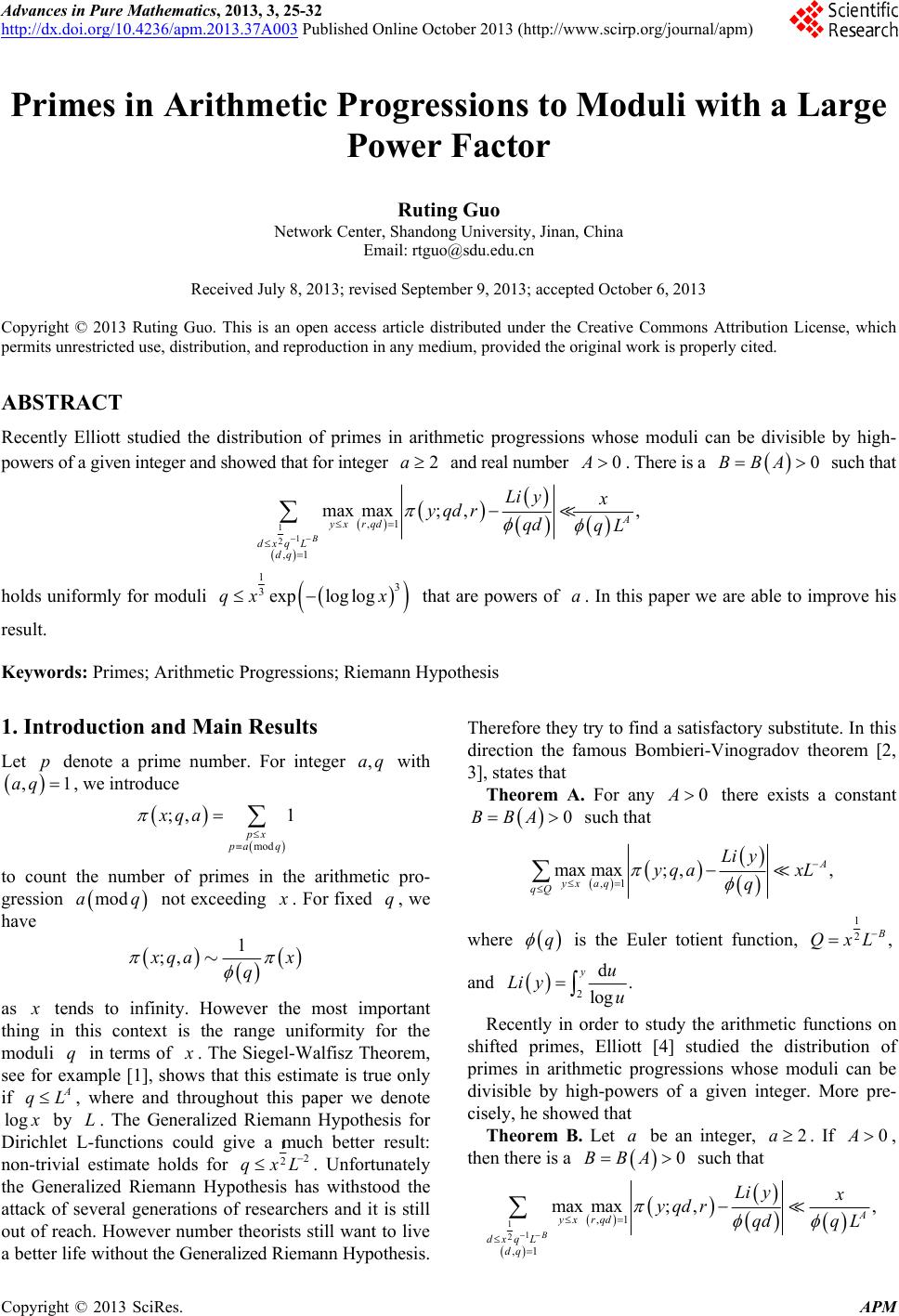 Advances in Pure Mathematics, 2013, 3, 25-32 http://dx.doi.org/10.4236/apm.2013.37A003 Published Online October 2013 (http://www.scirp.org/journal/apm) Primes in Arithmetic Progressions to Moduli with a Large Power Factor Ruting Guo Network Center, Shandong University, Jinan, China Email: rtguo@sdu.edu.cn Received July 8, 2013; revised September 9, 2013; accepted October 6, 2013 Copyright © 2013 Ruting Guo. This is an open access article distributed under the Creative Commons Attribution License, which permits unrestricted use, distribution, and reproduction in any medium, provided the original work is properly cited. ABSTRACT Recently Elliott studied the distribution of primes in arithmetic progressions whose moduli can be divisible by high- powers of a given integer and showed that for i nteger and real number Ahere is a B ch that 2 a Tsu0. 0BA 11 2 ,1 ,1 max max;,, B A yx rqd dxqL dq Li yx yqdr qd qL 13 3exp loglogqx x holds uniformly for moduli that are powers of . In this paper we are able to improve his eywords: Primes; Arithmetic Progressions; Riemann Hypothesis 1. Introduction and Main Results with to count the number of primes in the arithmetic pro- a result. K Let p denote a prime number. For integer,aq ,1aq , we introduce ;,xq mod 1 px pa q a gression modaq not exceeding . For fixed q, we have 1 ;, qa x q as tends to infinity. However the most important thinin this context is the range uniformity for the moduli q in terms of g . The Siegel-Walfisz Theorem, see for eample [1], shows that this estimate is true only if A qL, where and throughout this paper we denote log x by L. The Generalized Riemann Hypothesis for let L-functions could give a much better result: non-trivial estimate holds for Dirich 12 2 qxL . Unfortunately the Generalized Riemann Hypos withstood the attack of several generations of researchers and it is still out of reach. However number theorists still want to live a better life with ou t the Generalized Riemann Hypothesis. direction the famous Bombieri-Vinogradov theorem [2, 3], states that Theorem A. For any 0A there exists a constant thesis ha Therefore they try to find a satisfactory substitu te. In this 0BBA such that ,1 max max;y , , A yx aq qQ Li y qa xL q where q is the Euler totient function, 1 2, QxL and 2 d. log yu Li u Re y cently in order to study the arithmetic functions on shifted primes, Elliott [4] studied the distribution of primes in arithmetic progressions whose moduli can be divisible by high-powers of a given integer. More pre- cisely, he showed that Theorem B. Let a be an integer, 2a. If 0A, then there is a 0ABB such that 11 2 ,1 ,1 max, Li yx r max ;, B A yx rqd dxqL dq yq dqd qL C opyright © 2013 SciRes. APM  R. T. GUO 26 3 3exp loglogqx x holds uniformly for moduli 1 that are powers of When result recovers the Bombieri- Vinogradov theorem. And obviously his result gives a n of primes in arithmetic st imp a. , his 1q deep insight into the distributio progressions. The moortant thing Elliott concerned in [4] is that in Theorem B the parameter q may reach a fixed power of . However we want to purse the widest uniformity in q by using some techniques estab- lis l new hed in the study of Waring-Goldbach problems. We shall prove the following resut. Theorem 1.1. Let a be an integer, 2a. If 0A, then there is a 0BA such that B 11 2 ,1 ,1 B yx rqd dxqL dq qd q max max;,Li yq dr , A L holds uniformly for moduli yx 23 5exp loglogqx x that are powers of When and an odd prime, our result gives that for tmoduli with the form a. 1d hes a e particular q ,1,2,3, n qpn ;, 1, A xqrO Lq Li x holds uniformly for moduli 23 5exp loglog.qx x Then the special case of our result shows that the least prime in these special progressions satisfies min ,Pqr mod qnr 52 min ,.Pqr q Thisproves a former result given by Barb hudakov [5 result iman, Linnik and Ts], 83 min ,Pqr q where ,1,2,3, n qpn. If we focus our attention on the least prime in arithmetic progressions with special moduli, we can prove the following result. rem 1.2. Let be anteger, . If th Theo n i a 2a0A, en there is a 0BBA such that 91 20 ,1 ,1 B yx rqd dx qL dq qd q max max;Li yx y , , A q dr L holds uniformly for moduli 53 12 exp loglogqx x that are powers of Then our resuows that the least prime a. lt sh min ,Pqr in these special progressions modnr q satisfies 12 5 min ,Pqr It should be remrk .q aed that the Generalized Riemann Hld allow ypothesis for Dirichlet L-functions wou 11 2A qdxL with no further restrictionpon the natu ure of . Therefore our Theorems 1.1 and 1.2 can be compared with the resu lt under the Geralized Riemann H 2. Prelimin qen ypothesis. ary Reduction Let n denote von Mangoldt’s function, and for mutually prime integers w and r, let ;, . w ywrn r mod ny nr Fo 34 2wx and an integer 1q, define ,1 ,1 1 max max;,;,. rqdyx dw dq Gwyqdr yqr d Lemma 2.1. For any Then0,1 41 2K , we have 3 1 6 1 1 exp logloglog 2 log . K K GxqL Gxx qq xx (1) unteg ers iformly for positive in 3 exp loglog,3qxxx where 25 , if 920 12 and 512 , if 14 920 . Here 1q |nq . For Dirichlet characters an defind real e 0y ny yn ,.n Lemma 2.t (2) 2. Le ,y defined as in (2). Then 12 2512 max ,c yxxQDQDL 4 mod , yx dQ Dd x ho ers Lemma 2.3. Let (3) lds uniformly for all integers 1D and real numb 2, 1.xQ ,y defined as in (2). Then 11 202 mod max ,. c yx dQ Dd yxxQD L ds uniformly for all integers the innall racters 3. Proof of Lemma 2.2 (4) hol and real numbers 1D 2, 1.Q Here er sum is taken over hlet cha mod Dd . x primitive Dirc Let 2 5 YX Copyright © 2013 SciRes. APM 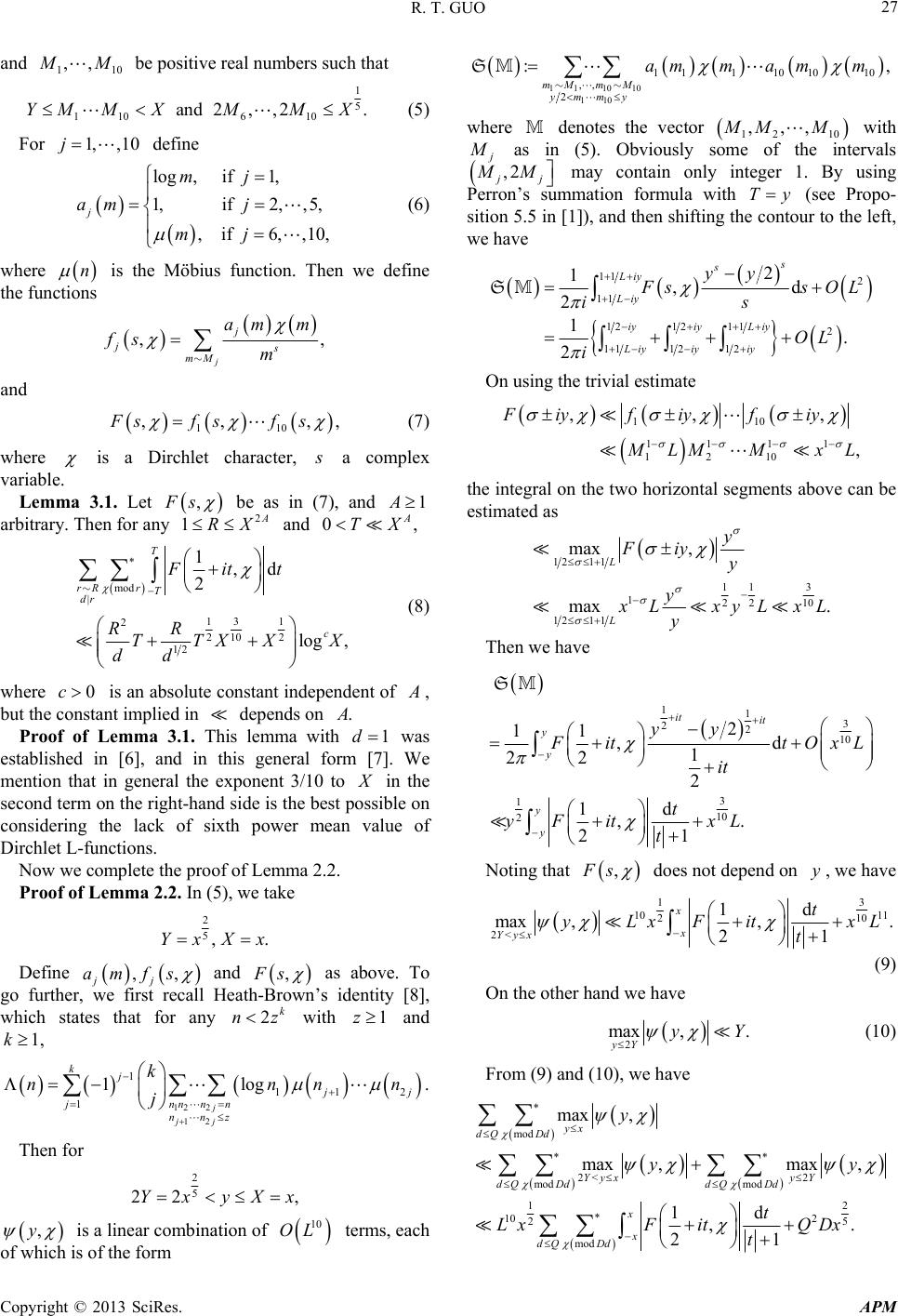 R. T. GUO 27 and 110 ,, M be positive real numbers such that 1 5 1106 10 and 2,,2.YMM XMM X (5) For define where is the Möbius function. Then we define the fu 1, ,10j 1, if2,, 5, ,if 6,,10, j am j mj log ,if1,mj (6) n nctions , j j js mM am m fs m , , and 110 ,, ,Fsfsfs (7) where is a Dirchlet character, a complex variable. mma 3.1. Let Le ,Fs be as in (7), and 1 0, arbitrary. Then for an and y 12A RX A TX mod | 3 2log dr RR T ) 11 10 22 12 2 , rR rT c T XX X dd (8 where is an absolute constant independent of 1,d TFitt 0c , but thmplied in depends on e constant i. Proof of Lemma 3.1. This lemma with 1d was established in [6], and in this general formWe mention that in general the exponent 3/10 to [7]. in the o ixnvalue of D second termon the right-hand side is the best possiblen considering the lack of sth power mea irchlet L-functions. Now we complete the proof of Lemma 2.2. Proof of Lemma 2. 2. In (5), we take 2 5,.YxXx Define ,, jj amfs and ,Fs as above. To go s identity [8], whic and further, we first recall Heath-Brow kn’ 2nz with h states that for any1z 1,k 12 2 12 11 2 1lo j jj k 1 1 g j j jnnnn nnz nnn j kn The for . n 2 5 22YxyXx , ,y of which is of t 1 11010 110 111101010 ,, 2 :, mMmM ymmy amma mm S where denotes the vector 12 with 10 ,,,MMM as in (5). Obviously some of tervals the in ,2 j MM may contain onusing mmation formPropo- sition 5.5 in [1]), and then shifting the contour to the left, we have ly integer 1. By ula with Ty (see Perron’s su 11 2 11 1212112 1112 12 2 1,d 21. 2 s s Liy Liy iyiy L Liy iyiy yy iy ssOL is OL i On usin S g the trivial estimate 110 1111 1210 ,, , Fiyf iyfiy, LMMx L the integral on the two horizontal segments above can be estimated as 121 1 3 11 110 22 121 1 max . L max , L y Fiyy y LxyLxL y Then we ha ve 113 2210 3 1 10 2 2 11 ,d 1 22 2 1d ,. 21 it it y y y y yy ittO xL it t yF itxL t S ,Fs does not depend on , we have y Noting that 3 1 10 11 10 2 2< 1d max ,,. 21 x x Yyx t yLxFit x t L (9) hand weOn the other have 2 max ,. yY yY (10) From (9) and (10), we have mod max , yx Q Dd y is a linear combination of terms, each he form 10 OL 2< mod mod 2 25 2 mod max , d ,. 21 d Yy x dQ DddQDd x dQ Dd yy t Lx F itQDx t 2 max , y Y 1 10 1 x Copyright © 2013 SciRes. APM  R. T. GUO 28 Further let and then we obtain qDd mod 12 12 2 01 mod | 2 25.QD x max , 11 max max,d 12 yx dQ Dd T T Tx RQDqR q Dq y LxF itt T From Lemma 3.1, we have mod 3 111 2 210 22 12 01 2 2 3 11 10 22 2 12 2 25 4 11 25 22 max , 1 max max1 11 . yx dQ Dd c Tx RQD c c y RR LxTT xx TD D QD QD LxTxxT DD QDx xxQDxQD L This completes the proof of Lemma 2.2. 4. Proof of Lemma 2.3 Firstly we recall one result of Choi and Kumchev [9] about mean value of Dirichlet polynomials. Let and Let denote the er 5 2 11 QD x 1, 1,mr set of charact,Qr ,,mrQ modulre o mq, whe is a character modulo m and is a primitiv , e cacter with har modulo qrqQrq and qm,1. as fos. Then the result of Choi and Kumchev states llow Lemma 4.1. Let 1,1,2,2,mrT N and ,,mrQ be a set of characters as described as above, Then 11 20 ,, 2d, Tit c T mrQNnN nnnt NHNL where c is an absolute constant, 12 mrQ T and plete the log .HN Now we com 2.3. Lemma 2.3. Let L Proof ofproof of Lemma 1 2 Yx and x . We define ,. YnX sn nn If satisfies wrmula y ,YyX (11) e apply Perron’s summation fo with Ty (see Proposi 12 12 2 d ,s OxL s 2 1 ,,d 2 2 , 2 s s biy biy s s iy biy yy yFs sOxyL is yy Fs i 1b where 1 0.bL If we let 0,b we have 12 1 ,,d 1 y y yFit tOxy t .L Noting that ,Fs does not depend on , we have y 12 2 d max ,,. 1 x x Yyx itOxL t yF t (12) On the other hand we have 1 2 2 max ,. yY Yx (13) From (1 2 ) and (13) , we h ave tion 5.5 in [1]), and then obtain mod 2 mod mod 1 2 2 max , max , d ,. yx dQ Dd YyxyY dQ DddQ Dd x y y t Fit QDxL 2 mod1 x dQ Dd t max ,y Further let qDd and then we obtain mod 1 222 2 01 mod | max , 1 max max,d. 1 yx dQ Dd T T Tx RQDqRDd Dq y ittQDxL T Lemma 4.1 = 1 gives that with m 11 2 220 mod | ,d Tc T qR Dd Dq RT . ittxxL D (14) From (14), we have mod yx dQ Dd 11 1 222 20 2 01 211 1 122 2 11 2 20 max , 1 max max1 1 . c Tx RQ c y RT 20 c xLQDx TD QD xTQDxL xxQDL This completes the proof of Lemma 2.3. L Lx D Copyright © 2013 SciRes. APM 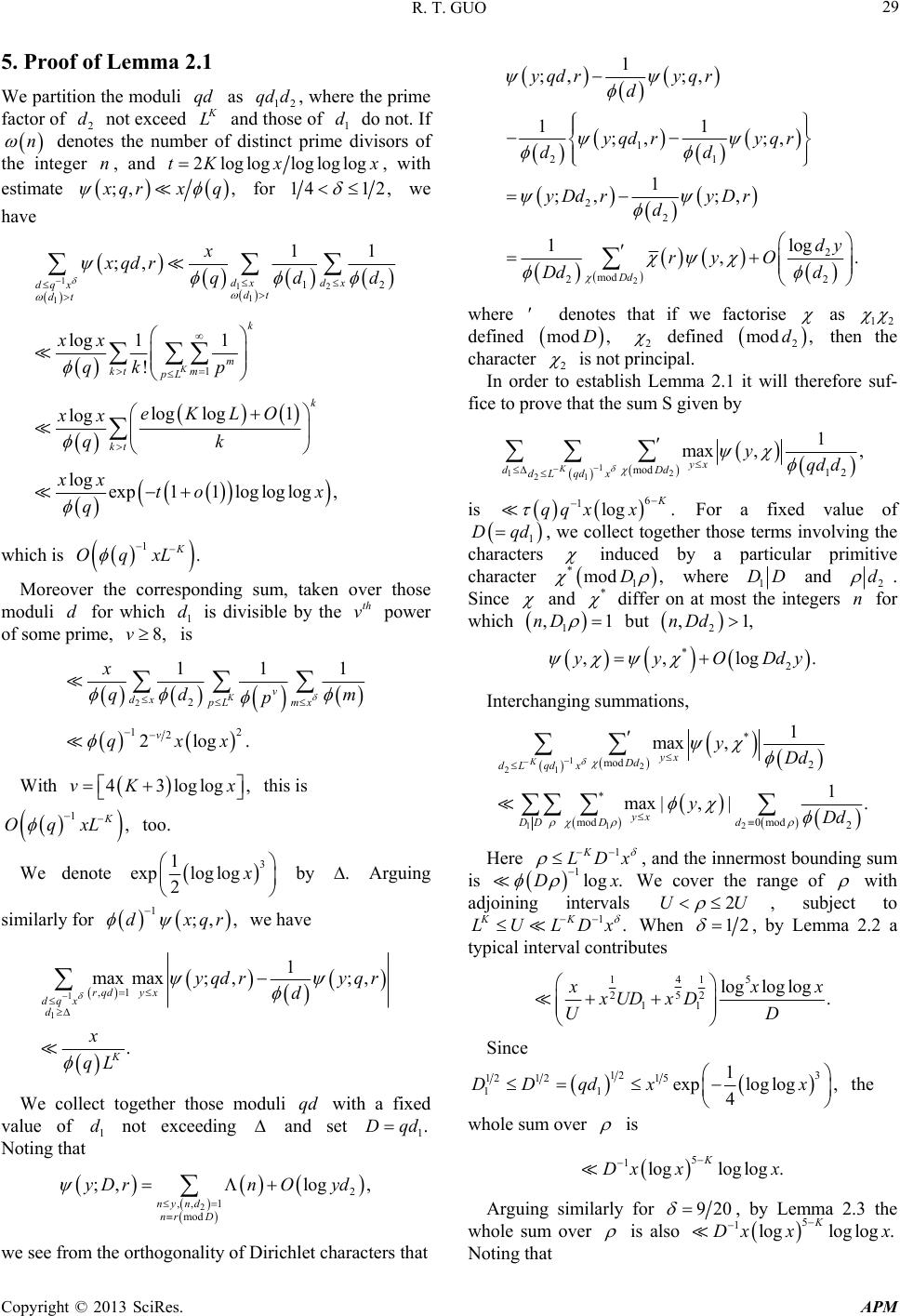 R. T. GUO 29 5. Proof of Lemma 2.1 We partition the moduli as , where the prime factor of not exceed qd 12 qd d 2 d L ber of anofdo not. I f detes the num ct primdivisors of and d those distin 1 d e n the integer no n,2ltKoglog loglx oglog x, with estimate ;, , qrx q for 14 12, we have 112 112 11 ;, log 11 lo g gexp11 llog, dx dx dq xdt dt m x xqdr qdd xx xto x q which is Moreover the corresponding sum, taken over those moduli for which is divisible by the power of someme, 1 k 1 !K kt m pL qk p log g1 lo k kt eK LO xx qk lo oglog x 1. K OqxL d pri1 d is th v 8,v 22 12 2 11 2log. Kv dx pLmx v x qd p qxx 1 m With , this is 43loglogvK x 1, K xL too. Oq We denote 3 1 exp loglog 2 by . Arguing similarly for 1;, ,dxqr we have 1 1 ,1 1 max max;,;, . rqdy x dq x d K yqdr yqr d x qL We collect together those moduli with a fixed value of needing set qd and 1 dot exc1.Dqd Noting that we see from the orthogonality of Dirichlet characters that yDr 2 2 ,,1 mod ;,log, nynd nr D n Oyd 2 1 21 22 ;, ;, g 1 yD d ryDr d dy 2 mod 22 1 ;, ;, 11 ;, ;, 1 lo ,. Dd yqdryqr d yqd ryqr dd ry O Dd d where denotes that if we factorise ' as 12 defined mod ,D defined the , 2 2 character 2 moddn the is not principal. In ma fice to prove that the sum S given by order to establish Lem 2.1 it will therefore suf- 1 12 21mod 12 1 max ,, Kyx dDd dL qdx yqd d 6 1log . qq xx is For a fixed value of 1 Dqd, we collect togethe characters r those terms involving the induce character d by a particular primitive *1 mod ,D where 1 DD and 2 d . Since and * differ on at most the integers for n which ,1nD 1 but 2 ,1,nDd *O 2 ,,logyy Dd .y Interchangi ng sum mations, 12 21 11 mod2 mod 1 max , 1 max |,|. Kyx Dd dL qdx yx DD D yDd y Here 2 0 mod2 dDd 1K LDx * , and the innermost bounding sum is og .Dx We cover the range of 1l with adjoining 2U intervals U subjeco . KK LULDx , tt 1 When 12 , by Lemma .2 a typical 2 interval contributes 4 11 5 5 22 11 loglog log . x xxUD xD U D Since 12 3 12 1215 11 1 exploglog , 4 DD qdxx the whole sum over is logloglog .x x Arguing similarly for 5 1K Dx 920 , by Lemma 2.3 the whole sum over is also 5 gloglog . K 1lo x x x Noting that Copyright © 2013 SciRes. APM 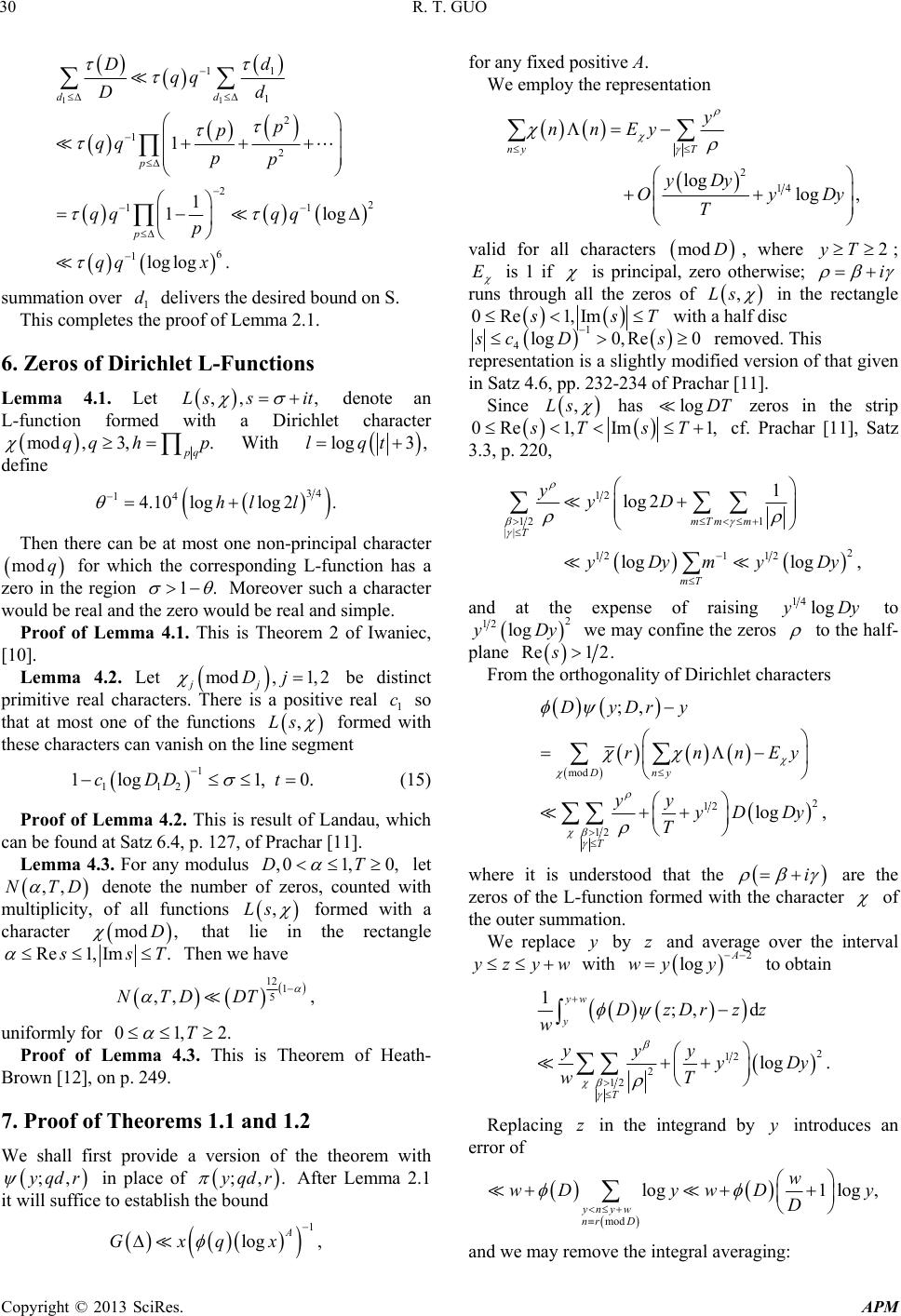 R. T. GUO 30 11 1 1 1 2 1 2 22 1 6 1 1 1 1 loglog . dd p p 1 l og d Dd p p qq pp qq qq p qq x summation over delivers the desired bund on S. f of Lem icunctions Lemma 4.1. Let , denote an L-function formet character D qq 1 d o This completes the prooma 2.1. 6. Zeros of Dirhlet L-F ,,Ls sit ed with a Dirichl mod ,3,. pq qq hp With log3,lqt define 34 14 4.10 loglog2.hl l Then there can be at most one non-principal character for which the corresponding L-function has a region mod q zero in the1. Moreover such a character would be real and the zero would be real and simple. , [1Lemma 4.2. Let be distinct e real so Proof of Lemma 4.1. This is Theorem 2 of Iwaniec 0]. mod, 1,2Dj v functions ,Ls jj primitive real characters. There is a positi1 c that at most one of the formed with these characters can vanish on the line segment 1, t ) 1 112 1logcDD 0. (15 Proof of Lemma 4.2. This is result of Lawhich can be found at Satz 6.4, p. 127, of Prachar [1]. ndau, 1 Lemma 4.3. For any modulus ,01, 0,DT let ,,TD denote the number of zeros, counted with multiplicity, of all functions ,Ls N formed with a character mod ,D that lie in the rectangle Re1, Im. sT Then we have 12 1 5 ,, ,NTD DT uniformly for 01,2.T Proof of Lemma 4.3. This ism of Heath- Brown [12], on p. 249. Theore 7. Proof of Theorems 1.1 and 1.2 We shall first provide a version of the theorem with ;, qd r in place of ;,. qdr After Lemma 2.1 ed positive A. We employ the repr it will suffice to establish the boun 1 lo , A Gxq for any fixesentation d gx 2 14 log log , yD y OyDy nyT y nnEy T valid for all characters mod D, where ; 2yT E is 1 if is principal, zero otherwise; i runs through all the zeros of ,Ls in the rectangle 0Re 1,Im sT with a ha disc lf 1 4log0,Re 0sc Ds remove versi d. Th o in Satz 4.6, pp. 232-234 of Prachar [11]. is givenrepresentation is a slightly modified n of that Since ,Ls has log DT zeros in the strip 0Re1, Im1,sT sT 220, cf. Prachar [11], Satz 3.3, p. 12 12 1 || 2 12112 1 log 2 loglog , mTmm T mT yyD yDymyDy and at the expense of raising 14log Dy to 2logyDy we may confine the zeros 2 1 to the half- plane Re12.s of Dirichlet characters From the orthogonality mod 2 12 12 log , Dny T yy yD Dy T where it is understood that the ;,DyDry rnnEy i with the character arethe zeros of the L-function formed of the outer summation. We replace byand average over the interval y z zyw with 2 log A wyy to obtain 2 12 2 12 1;,d log . yw yzDrzz wD T yy y Dy wT Replacing in the integrand by introduces an error of z y modnr D and we may remove the integral averaging: log1 log, ynyw w wD ywD y D Copyright © 2013 SciRes. APM 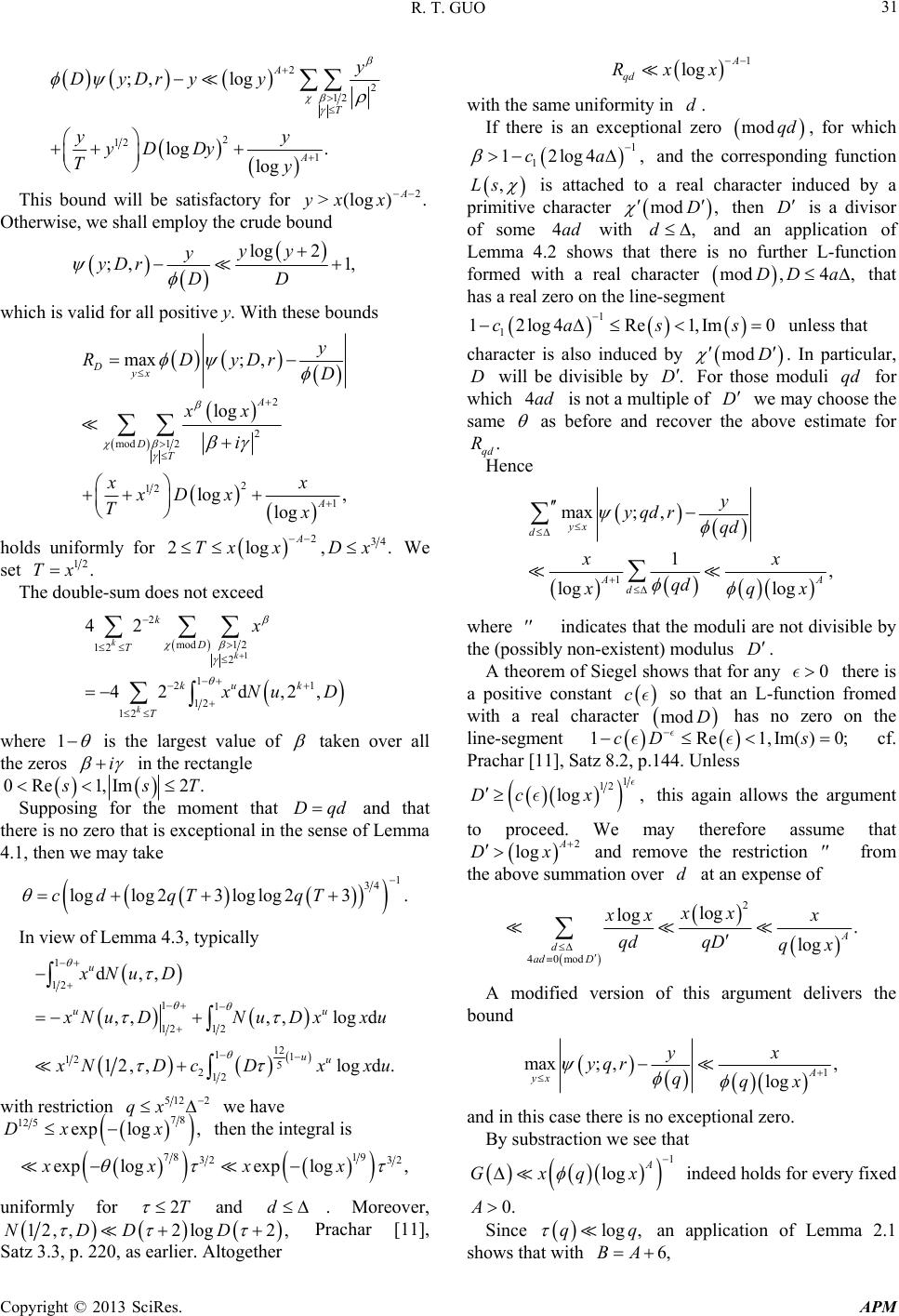 R. T. GUO 31 2 2 12 ,log A T Dy Dry y 2 12 1 ; log . log A y yy yD Dy Ty This bound will be satisfactory for Otherwise, we shall employ the crude b.)log(> 2 A xxy ound log 2 ;, 1,y rDD yy y D which is valid for all positive y. W ith these bounds 2 logA xx 2 mod1 2 2 12 1 max; , log , log Dyx DT A y RDyDr D i xx xD x Tx holds uniformly for 234 2log, A Tx xDx . We set 12 .Tx The double-sum does not exceed 1 2 mod1 2 12 2 1 21ku k 12 12 42 42 d,2, k k k k D T T x NuD where 1 is the largest value of taken over all the zeros i in the rectangle 0Re 1,Im2. sT Supp for the moment that and that there is no zero that is exception al in tha 4.1, then we may take osing Dqd e sense of Lemm 1 34 loglog 23loglog 23.c dqTqT InLe view of mma 4.3, typically 1u 12 11 12 12 12 11 12 5 212 d,, ,,,,lo d 12,,logd . uu uu xNu D g Nu DNu Dxxu NDcDxxu with restriction 512 2 qx we have integral is 78 12 5exp log,Dx x then the 78 19 32 32 exp logexp,xxxlog x uniformly for 2T and d . Moreover, 2, her 12, ,NDD 2 l s earlier. 1 log A qd Rxx ogD Prachar [11], Satz 3.3, p. 220, aAltoget with for which ,and the corresponding function the same uniformity in d. If there is an exceptional zero mod qd , 1 1 12log4ca ,Ls is attached to a real character induced by a itive character prim mod ,D ,d thenis a disor with D vi of some4ad a ows that there is no character e line-se nd anication of fuher L-function that n th 0 appl rt ,DD Lemma 4.2 sh formed with a real mod has a real zero ogment 4 ,a 1 1 12log4Re 1,Imcas s unless that character is also induced by. In particul, le by mod D ar D will be divisib .D For those m le of D we m oduli qd for which 4ad is not ay choose the same a multip as before and recover the above estima for . qd R te Hence 1, log log AA dqd xq x where '' icates that the moduli are not divisible by the (possibly non-existent) modulus D. A theorem of Siegel shows that foere is a positive constant max;,yq dr 1 yx dqd y xx ind r any th 0 c so that an L-ffromed with a real chunction aracter mod D has n o zero on the line-segment ()0;cD s e1R1,Im cf. Prachar [ 1 1], Satz 8. 2, p .144. Unles s 1 12 log ,Dc x this again allows the argument to pceed. We may therefore assume that ro 2A Dxlog the above summ and remove the restriction from ation over at an expense o '' f d 2 40mod log log . log A d ad D xx xx x qdqD qx A modified version of this argument delivers the bound 1A o excepti tion we see that max;,, log yx yqrqqx and in this case there is nonal zero. By substrac yx 1 lo A Gxqx g indeed holds for every fixed 0.A Since log ,qq an application of Lemma 2.1 6,BA shows that with Copyright © 2013 SciRes. APM 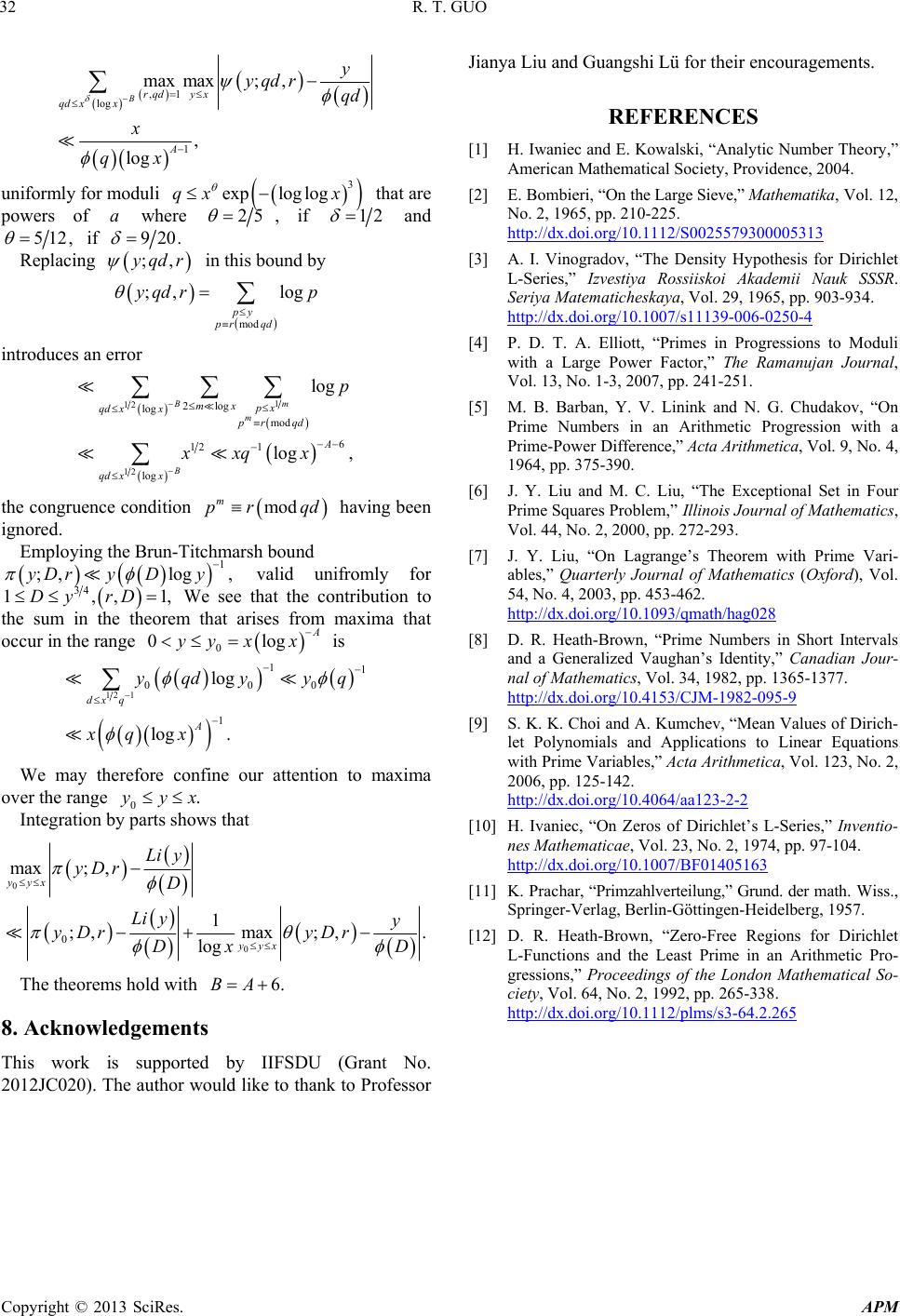 R. T. GUO Copyright © 2013 SciRes. APM 32 ,1 log 1 max max;, , log Brqdy x qd xx A y yqdr qd x qx of wh uniformly for moduli 3 exp loglogqx x that are powers aere 25 , if 12 and 512, if 920. Replacing ;, qd r in this bound by ;, log py yqdr p moprdqd introduces an error 12 12 log 6 12 1 log log log , Bm B qd x x A qd xx p xxq x the congruence condition havi ignored. Employing the Brun-Titchmarsh bound valid unifromly for 1 2log mod m mx px pr qd mod m pr qdng been 1 ;,log ,yDry Dy 34 1,,1,DyrD bution to the sum in the theorem s from that e rangeA yy occur in th We see that the contri that arise maxima g is 0 0loxx 12 1 1 logdy y 1 000 1 log . dx q A yq q xq x e confine our attention to maxima over the range Integration bys that We may therefor 0.yyx parts show 0 max;, 1max; yyx Li y yDr D yD D The theorems hold with 0 logyy x Dx 6. 0;, , . Li yy yDr r BA 8. Acknowledgements This work is su (Gpported by IIFSDUrant No 2012JC020). Th e author would like to thank to Prof Jianya Liu and Guangshi Lü for their encouragements. REFERENCES [1] H. Iwaniec and E. Kowalski, “Analy tic Number Theory,” American Mathematical Society, P r o v i d e n c e , 2004. [2] rge Sieve,” , Vol. 12, 0025579300005313 E. Bo mb ie r i, “ On the LaMathematika No. 2, 1965, pp. 210-225. http://dx.doi.org/10.1112/S [3] A. I. Vinogradov, “The Density Hypothesis for Dirichlet L-Series,” Izvestiya Rossiiskoi Akademii Nauk SSSR. Seriya Matematicheskaya, Vol. 29, 1965, pp. 903-934. http://dx.doi.org/10.1007/s11139-006-0250-4 [4] P. D. T. A. Elliott, “Primes in Progressions to Moduli with a Large manujan Journal, Vol. 13, No. 1 h a t in Four - ford), Vol. Power Factor,” The Ra -3, 2007, pp. 241-251. [5] M. B. Barban, Y. V. Linink and N. G. Chudakov, “On Prime Numbers in an Arithmetic Progression wit Prime-Power Difference,” Acta Arithmetica, Vol. 9, No . 4, 1964, pp. 375-390. [6] J. Y. Liu and M. C. Liu, “The Exceptional Se Prime Squares Problem,” Illinois Journal of Mathematics, Vol. 44, No. 2, 2000, pp. 272-293. [7] J. Y. Liu, “On Lagrange’s Theorem with Prime Vari ables,” Quarterly Journal of Mathematics (Ox 54, No. 4, 2003, pp. 453-462. http://dx.doi.org/10.1093/qmath/hag028 [8] D. R. Heath-Brown, “Prime Numbers in Short Intervals and a Generalized Vaughan’s Identity,” Canadian Jour- nal of Mathematics, Vol. 34, 1982, pp. 1365-1377. http://dx.doi.org/10.4153/CJM-1982-095-9 [9] S. K. K. Choi and A. Kumchev, “Mean Values of Dirich- let Polynomials and Applications to Linear Equations with Prime Variables,” Acta Arithmetica, Vol. 123, No. 2, 2006, pp. 125-142. http://dx.doi.org/10.4064/aa123-2-2 [10] H. Ivaniec, “On Zeros of Dirichlet’s L-Series,” Inventio- nes Mathematicae, Vol. 23, No. 2, 1974, pp. 97-104. http://dx.doi.org/10.1007/BF01405163 [11] K. P rach ar, “Primzahlverteilung,” Grund. der mat h. W iss. , Springer-Verlag, Berlin-Göttingen-Heidelberg, 1957. [12] D. R. Heath-Brown, “Zero-Free Regions for Diri L-Functions and the Least Prime in an Archlet ithmetic Pro- gressions,” Proceedings of the London Mathematical So- ciety, Vol. 64, No. 2, 1992, pp. 265-338. http://dx.doi.org/10.1112/plms/s3-64.2.265 . essor
|